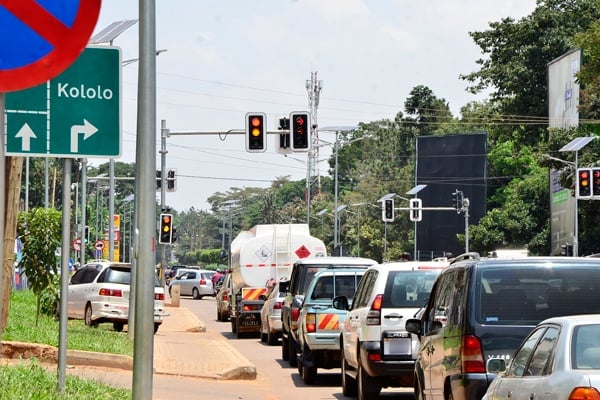Bad motorist behaviour cause of 48% Kampala traffic jam, report

Traffic lights at Yusuf Lule Road in Kampala. PHOTO | FILE
What you need to know:
- Reacting to the study, Mr Sam Bambaza, a road safety advocate and the founder of Hope for Victims of Traffic Accidents (HOVITA) said driver behaviour is the least factor that can be thought about when it comes to Kampala traffic jam.
Majority of traffic jam incidents (TJIs) in Kampala capital city are caused by motorists’ behaviours a study titled: Characterising Peak-Time Traffic Jam Incidences in Kampala conducted by scientists at Islamic University in Uganda (IUIU) has revealed.
The study analysed 483 TJIs in 2022 and found out that 233 TJIs translating to 48.2 per cent were due to motorist behaviours.
Of these; boda boda riders contributed to 42 TJIs, government cars 47, organisation cars 23, private cars 48, and public taxis contributed to 144 TJIs.
The study pointed out three major motorist behaviour such as; abrupt stop, where a motorist suddenly stops in the middle of the road thereby blocking traffic flow; abrupt turn- when a motorist abruptly makes a wrong turn in the middle of the road resulting into a temporary halt of traffic flow and lane disruption where a motorist joins a lane they should not be joining thereby disrupting traffic flow from the opposite.
“Whereas road infrastructural improvement is warranted in order to improve traffic flow, introducing interventions to address inappropriate on-the-road motorists’ behaviour could alone improve traffic flow in Kampala,” reads the study in part.
The intervention of traffic police officers in a bid to regulate traffic flow also contributed to 125 (25.9 percent) of traffic jam incidents during the period under review.
“It was observed that in trying to regulate traffic flow during peak-time hours (both early-morning and late-afternoon), traffic police officers were found to have caused 125 of the total traffic jam incidents, primarily because their on-site traffic flow decisions are largely subjective in nature and are not backed by real-time traffic jam incident data along the connected routes,” the study adds.
Road blockage factors such as; poor drainage, motor vehicle failure, accident incidents, traffic diversions, on-going construction works, also contributed to TJIs.
Speaking to this publication, Dr Umar Yahya, the principal investigator of the study said that traffic jam can reduce if driver behaviour is regulated.
“These results offer traffic regulatory and urban planning authorities, quantitative insights into possible feasible approaches to addressing traffic jam in Kampala and similar cities both in the short-term and long-term,” he said.
The study also revealed that Kampala experiences the highest number of TJIs in the evening with 272 (56 percent) of incidents reported in the study period.
“This is more likely due to the fact that motorist have a wider time window to enter Kampala Central Business District in the morning, than they have in the evening. This is also logical from a viewpoint of varying reporting times to work especially for the self-employed and business motorists, when compared to the nearly uniform exit times from the CBD,” Dr Yahya said.
He said that the rationale of the study was to establish, beyond the road infrastructural factors, “the extent to which motorists on-the road behaviour contributes to traffic jam incidents during both the dawn and sunset traffic peak-hours.”
Reaction
Reacting to the study, Mr Sam Bambaza, a road safety advocate and the founder of Hope for Victims of Traffic Accidents (HOVITA) said driver behaviour is the least factor that can be thought about when it comes to Kampala traffic jam.
“The problem is having many taxis in the city and concentration of government offices which need to be transferred to the outskirts. Let’s replace 14-seater’ Taxis with 80 seater’ buses and traffic won’t be seen anywhere,” he said.


